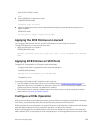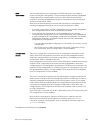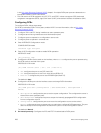
Behavior of Tagged Packets
The below is example for enabling PFC for priority 2 for tagged packets. Priority (Packet Dot1p) 2 will be
mapped to PG6 on PRIO2PG setting. All other Priorities for which PFC is not enabled are mapped to
default PG – PG7.
Classification rules on ingress (Ingress FP CAM region) matches incoming packet-dot1p and assigns an
internal priority (to select queue as per Table 1 and Table 2).
The internal Priority assigned for the packet by Ingress FP is used by the memory management unit
(MMU) to assign the packet to right queue by indexing the internal-priority to queue map table (TABLE 1)
in hardware.
PRIO2COS setting for honoring the PFC protocol packets from the Peer switches is as per above Packet-
Dot1p->queue table (Table 2).
The packets that come in with packet-dot1p 2 alone will be assigned to PG6 on ingress.
The packets that come in with packet-dot1p 2 alone will use Q1 (as per dot1p to Queue classification –
Table 2) on the egress port.
• When Peer sends a PFC message for Priority 2, based on above PRIO2COS table (TABLE 2), Queue 1 is
halted.
• Queue 1 starts buffering the packets with Dot1p 2. This causes PG6 buffer counter to increase on the
ingress, since P-dot1p 2 is mapped to PG6.
• As the PG6 watermark threshold is reached, PFC will be generated for dot1p 2.
Configuration Example for DSCP and PFC Priorities
Consider a scenario in which the following DSCP and PFC priorities are necessary:
DSCP
0 – 5, 10 - 15 20 – 25, 30 – 35
Expected PFC
Priority
1 2
To configure the aforementioned DSCP and PFC priority values, perform the following tasks:
1. Create class-maps to group the DSCP subsets
class-map match-any dscp-pfc-1
match ip dscp 0-5,10-15
!
class-map match-any dscp-pfc-2
match ip dscp 20-25,30-35
2. Associate above class-maps to Queues Queue assignment to be based on the below table (This
internal table has been modified for Z9500 platform) .
Table 10.
Internal-
priority
0 1 2 3 4 5 6 7
Queue 1 2 0 3 4 5 6 7
264
Data Center Bridging (DCB)


















